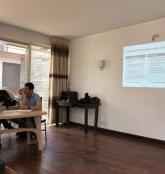Sports fans around the world have witnessed impressive winning streaks throughout history. After capturing two consecutive UEFA European Championships (2008, 2012) and a World Cup championship (2010), the Spanish National Football Team entered the 2014 World Cup in Brazil as the top-ranked squad in international competition. The dominant Spaniards were among the international sportsbooks’ favorites to bring home the trophy once again.
Instead, surprising defeats at the hands of the Netherlands and Chile eliminated Spain at the group stage. Spain’s streak of dominance came to a sudden end, marking the earliest World Cup exit for a defending champion since 1950.
From a meteorological perspective, the United States is currently riding its own streak: ten Atlantic hurricane seasons without a major hurricane (category 3 or above) making landfall, the longest such stretch in recorded history. With another hurricane season upon us, many will be keeping a keen eye on the Atlantic this summer to see if this impressive streak will continue.
Global forecasting groups, such as Colorado State University and Tropical Storm Risk, have issued their tropical storm and hurricane activity forecasts for the 2016 Atlantic hurricane season. Christopher Allen of the RMS Event Response team has authored an excellent summary of their forecasts in the RMS 2016 North Atlantic Hurricane Season Outlook published this week on RMS.com.
You can also listen to my summary of the season’s forecasts during my talk to AM Best TV’s John Weber. In summary, most forecasts are predicting anywhere between near-average to above-average activity in the Atlantic basin, reflecting conflicting signals in the key indicators that influence hurricane formation.
Will we have increased hurricane activity?
One factor that may support increased hurricane activity this season is the anticipated state of the El Niño-Southern Oscillation, or ENSO. As reported on this blog several months ago, many ENSO forecasts project a transition out of last year’s historic El Niño phase into a La Niña phase, which is historically more favorable for hurricane development. Wind shear, detrimental to tropical cyclone formation, typically is reduced in the Atlantic basin during La Niña phases of ENSO.
Conversely, some forecasts predict a cooling of Atlantic sea surface temperatures (SSTs), which would oppose any support provided by a forecasted La Niña and reduce the potential for an active hurricane season. This cooling has been driven by a lengthened positive phase of the North Atlantic Oscillation (NAO), which causes stronger than normal trade winds in the tropical North Atlantic and upwelling of deeper cold ocean water near the surface.
The Atlantic Multidecadal Oscillation may also be transitioning into a prolonged phase detrimental to tropical cyclone development, a theory often mentioned on this blog, although one that is still debated in the scientific community.
If considered in isolation, La Niña conditions and cooling Atlantic SSTs exert conflicting influences on Atlantic tropical cyclone development. However, forecasts contain key caveats that will ultimately determine this season’s activity:
- Although a transition into a La Niña phase is widely anticipated, a late arrival would limit its ability to support development in the basin.
- Further, forecasts of Atlantic sea surface temperature during August and September, the peak of hurricane season, remain conflicted.
Does the season’s early storm activity signify more activity?
Forecasts predicting above-average basin activity are understandable, given the early activity observed prior to the season’s official start. Tropical Storms Bonnie and Colin both formed before the second week in June, bringing heavy rainfall to South Carolina and the Gulf coast of Florida, respectively. Bonnie and Colin followed Hurricane Alex, the first January hurricane since 1938.
Bonnie’s formation marked the first time since 2012 that two named storms developed before June 1, the official start of hurricane season. The 2012 season ended with 19 total named storms, the third-most on record, including Superstorm Sandy, which caused more than $18 billion in insured losses.
Would the industry be prepared for the next major hurricane landfall? According to Fitch, the answer is yes: insurers and reinsurers in 18 coastal U.S. states would be equipped to handle one major event this season, although this resiliency has not been recently tested. More worrying, though, are the prospects of a large tail event or even multiple landfalling events, which may be supported by the right combination of oceanic and atmospheric influences.
With the hurricane season now officially underway, we will watch, wait and see how the season’s activity unfolds over the next few months. What is certain, though, is that streaks are made to be broken. It’s just a matter of when.






